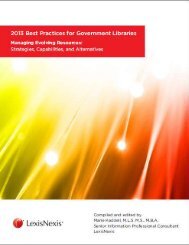2012 Best Practices for Government Libraries
2012 Best Practices for Government Libraries
2012 Best Practices for Government Libraries
You also want an ePaper? Increase the reach of your titles
YUMPU automatically turns print PDFs into web optimized ePapers that Google loves.
60<br />
BEST PRACTICES <strong>2012</strong><br />
librarians and in<strong>for</strong>mation professionals are left feeling disoriented and discouraged.<br />
Yet I believe it’s possible to re-orient ourselves in order to re-engage in the<br />
changing nature of in<strong>for</strong>mation and access.<br />
I think pushing our own boundaries, professionally or otherwise, involves going<br />
through three stages (not unlike Elisabeth Kubler-Ross’ five stages of grief:<br />
http://www.ekrfoundation.org/five-stages-of-grief).<br />
I’ve conveniently made them all start with the letter ‘A’:<br />
Acknowledge – recognize that this change in accessibility, mobility, and<br />
community has happened, and is continuing to happen. You can still feel<br />
resistant, angry, scared, excited, and any variety of other feelings. The<br />
important thing is to acknowledge that we perhaps don’t have a full<br />
understanding of the in<strong>for</strong>mation environment any longer, that there are<br />
many other participants in the in<strong>for</strong>mation world these days. We aren’t the<br />
gatekeepers any longer. The in<strong>for</strong>mation world is not the same as it was<br />
even five years ago.<br />
Accept – to accept is subtle yet profound. Acceptance is a portal through<br />
which you can actually start to take some action. Acceptance removes the<br />
judgment of the situation – good, bad, or otherwise – and allows you to<br />
actually start to see how you can work with the changes happening.<br />
Accepting is an opportunity <strong>for</strong> us to learn, and perhaps to act differently<br />
going <strong>for</strong>ward. Acceptance can actually be quite exciting and energizing.<br />
Advance – once we’ve accepted the situation(s), then we can take action<br />
without dragging along resentment and other baggage. We have the<br />
opportunity to take more control of our direction and our future, and we can<br />
feel less of a victim of our circumstances. We can start to work more<br />
effectively within the new in<strong>for</strong>mation environment.<br />
What is this new environment, and how do we engage with it?<br />
As we’ve already touched upon, the in<strong>for</strong>mation landscape has truly shifted – and I<br />
think there are still many of us who have not fully accepted and embraced this<br />
shift. The in<strong>for</strong>mation experience <strong>for</strong> a great many of our users is completely<br />
different from what our experience may have been.<br />
Have you heard the expression, “it’s better to ask <strong>for</strong> <strong>for</strong>giveness than <strong>for</strong><br />
permission”? To me, this encapsulates a major aspect of the new in<strong>for</strong>mation<br />
environment. And this is where the concept of pushing boundaries comes into play<br />
<strong>for</strong> us as in<strong>for</strong>mation professionals.<br />
For example, let’s look at the dynamics of social tools. Anyone with access the<br />
Internet has the ability to connect with anyone else on the Internet, and to create<br />
content. Think about that <strong>for</strong> a moment – anyone can create content. What we<br />
often <strong>for</strong>get, deny, and/or shy away from is the fact that we, as in<strong>for</strong>mation<br />
professionals, can be content creators as well – very powerful content creators.



